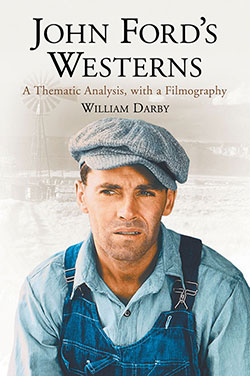John Ford’s Westerns
A Thematic Analysis, with a Filmography
$39.95
In stock
About the Book
John Ford’s early Westerns reflect an optimistic view of society and individual capacity; as his thematic vision evolved, he became more resigned to the limitations of humanity. His thematic evolution was evident in other films, but was best shown in his Westerns, with their stark depictions of the human condition. Ford’s sound Westerns and his major silent films are compared in this work, revealing how his creative genius changed over time. A complete filmography of Ford’s Westerns is also provided.
About the Author(s)
Bibliographic Details
William Darby
Format: softcover (6 x 9)
Pages: 317
Bibliographic Info: 22 photos, notes, bibliographies, index
Copyright Date: 2006 [1996]
pISBN: 978-0-7864-2954-7
eISBN: 978-1-4766-0752-8
Imprint: McFarland
Table of Contents
Acknowledgments ix
Introduction 1
1. Ford and the Filming of the West 5
2. Straight Shooting, The Iron Horse, and Three Bad Men 16
3. Thematic and Narrative Continuities: Drums Along the Mohawk and How the West Was Won 22
4. The Horse Soldiers 38
5. Ford’s Western Literary Sources and Their Adaptations 56
6. Fort Apache and Rio Grande 82
7. She Wore a Yellow Ribbon and Sergeant Rutledge 118
8. My Darling Clementine and The Man Who Shot Liberty Valance 147
9. Wagonmaster and Two Rode Together 185
10. Three Godfathers and The Searchers 216
11. Stagecoach and Cheyenne Autumn 249
Conclusion 279
Notes 283
Bibliography 287
Filmography: Ford’s Westerns 289
Index 298
Book Reviews & Awards
“the author explores [Ford’s great] achievement and provides detailed lists of Ford’s themes”—Choice; “worthwhile”—Western Clippings; “enough depth and detail to satisfy even the most devoted Ford fan. Darby brings the tools of a literary critic to bear on the films, exhaustively cataloging and extensively analyzing plot devices, characters, thematic elements, and musical motifs as well as strictly cinematic elements such as framing, camera angles, and pacing. Darby’s analysis is sure-footed…wide-ranging, fine-grained analysis”—Film and History; “a must”—Wrangler’s Roost; “detailed”—Canyon News; “directs our attention to many things we may have forgotten or overlooked…worthy”—Cult Movies; “readable and accessible…a rewarding book”—Past Times.





